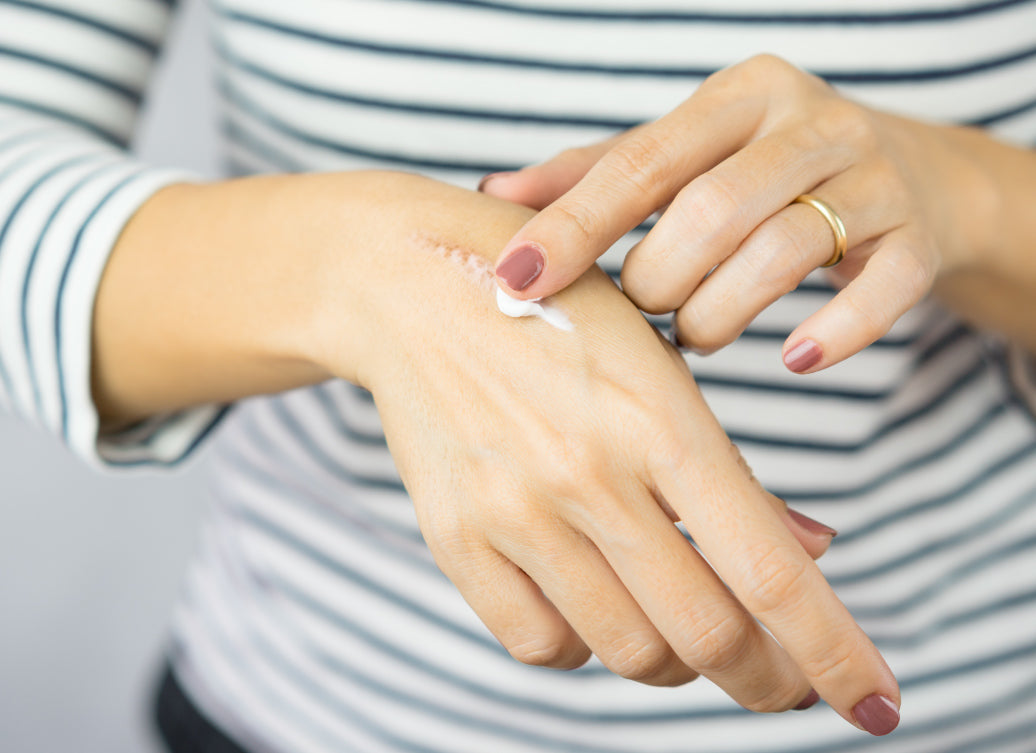The most important thing to know about scars is they vary considerably in appearance and in how much any kind of treatment works to fade or smooth them.
Some scars heal quickly and easily, others get thick, dark or bumpy. What can be done to change their appearance is limited, but there are definitely things that don't hurt to try.
What is a scar?
A scar is the tissue produced by the body after an injury, wound or trauma to the deepest layer of the skin. It works quickly to patch up the broken skin with collagen, making an area that doesn’t have the same look, colour and feel of normal skin.
Over the course of the next 12 to 18 months, the scar will change colour and texture until eventually it's as close to the surrounding skin as it’s likely to get.
How can you help scars to heal?
In the early stages of the healing process, the scar can feel tight, dry and uncomfortable. Once the initial wound has healed over, doctors advise people to keep the area clean and well moisturised, massaging oil or cream into the skin every day for at least six weeks (and up to a year) to keep the skin soft and smooth as it heals.
There’s good evidence to suggest that massaging rosehip oil into the skin in the early weeks can help healing, for example.
It’s also important to keep a healing scar protected from the sun, as sun exposure can damage new skin. It can burn or suffer from hyperpigmentation which can be very hard to resolve, so use a high factor sunscreen and keep to the shade.
What can you use on old scars?
A scar’s healed appearance will depend on many things, such as where on the body it is, how deep the injury was, what colour skin the patient has, and whether it healed without further trauma or infection.
The reality is that scars are very hard to improve after about 18 months. Some may never change appearance after that time unless you go to a cosmetic dermatologist for laser treatment, steroid injections or dermabrasion.
However it might be possible to make even old scars softer, more comfortable and smoother at home by the frequent use of appropriate creams or oils. And at the very least you’re going to be helping your skin stay healthy and in the best condition possible.
- Pick a product without irritants like perfumes and dyes, so your skin isn’t further inflamed.
- Choose something with essential fatty acids to help support skin cell regeneration - these can be found in natural oils like rosehip, sea buckthorn, hemp seed, olive, safflower, borage.
- Finally, if you can, use an all-natural product for maximum nourishment, and make sure it includes vitamin E to give your skin the best chance of healing well.
Cream or oil or balm?
In fact, it doesn’t matter which kind of emollient you use on your scar, so long as it fulfils these criteria:
- It doesn’t irritate the skin.
- It feeds the skin with nutrients.
- It works well as a massage medium.
Depending on what you feel most comfortable with and where on the body your scar is, we’d recommend using Balmonds Rosehip Scar Oil or Balmonds Skin Salvation balm to keep scar tissue in good condition.
You might find the oil easier to massage into the skin, and it’s certainly rich in scar-smoothing. Regenerative rosehip oil has been said to help support healing and minimise hyperpigmentation. But some scars might need the extra staying power of a salve, especially if they’re still feeling tight, itchy or dry.
Recommended products:
Balmonds Rosehip Scar Oil
with Rosehip
Balmonds Skin Salvation
with hemp and beeswax
